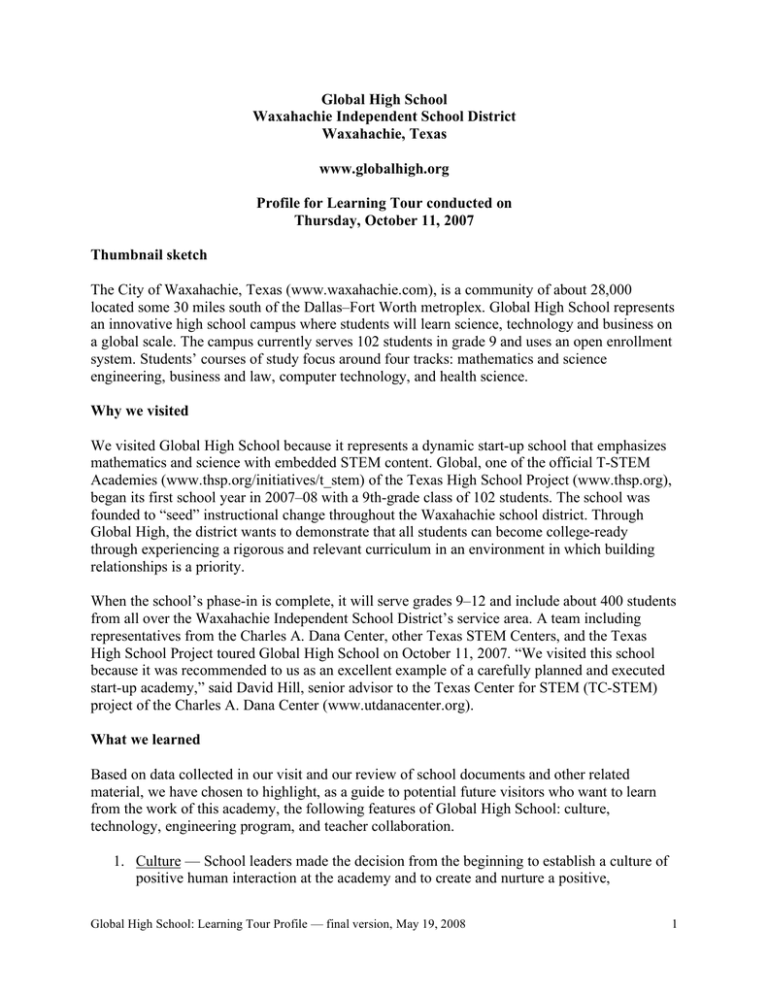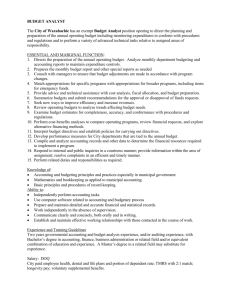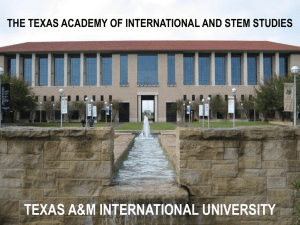Global High School Waxahachie Independent School District Waxahachie, Texas
advertisement

Global High School Waxahachie Independent School District Waxahachie, Texas www.globalhigh.org Profile for Learning Tour conducted on Thursday, October 11, 2007 Thumbnail sketch The City of Waxahachie, Texas (www.waxahachie.com), is a community of about 28,000 located some 30 miles south of the Dallas–Fort Worth metroplex. Global High School represents an innovative high school campus where students will learn science, technology and business on a global scale. The campus currently serves 102 students in grade 9 and uses an open enrollment system. Students’ courses of study focus around four tracks: mathematics and science engineering, business and law, computer technology, and health science. Why we visited We visited Global High School because it represents a dynamic start-up school that emphasizes mathematics and science with embedded STEM content. Global, one of the official T-STEM Academies (www.thsp.org/initiatives/t_stem) of the Texas High School Project (www.thsp.org), began its first school year in 2007–08 with a 9th-grade class of 102 students. The school was founded to “seed” instructional change throughout the Waxahachie school district. Through Global High, the district wants to demonstrate that all students can become college-ready through experiencing a rigorous and relevant curriculum in an environment in which building relationships is a priority. When the school’s phase-in is complete, it will serve grades 9–12 and include about 400 students from all over the Waxahachie Independent School District’s service area. A team including representatives from the Charles A. Dana Center, other Texas STEM Centers, and the Texas High School Project toured Global High School on October 11, 2007. “We visited this school because it was recommended to us as an excellent example of a carefully planned and executed start-up academy,” said David Hill, senior advisor to the Texas Center for STEM (TC-STEM) project of the Charles A. Dana Center (www.utdanacenter.org). What we learned Based on data collected in our visit and our review of school documents and other related material, we have chosen to highlight, as a guide to potential future visitors who want to learn from the work of this academy, the following features of Global High School: culture, technology, engineering program, and teacher collaboration. 1. Culture — School leaders made the decision from the beginning to establish a culture of positive human interaction at the academy and to create and nurture a positive, Global High School: Learning Tour Profile — final version, May 19, 2008 1 supportive, student-centered learning environment. The headmaster of the academy said, “We fought hard to start with just the ninth grade so we could establish a new culture. We believed that culture would the linchpin that holds together everything else we do.” The academy wants to produce graduates who are critical thinkers and effective problem solvers — confident and successful learners who are ready for college. To meet its goals and the needs of its diverse student population, the academy implemented a small learning community that includes an advisory program to make sure that no students fall through the cracks. School leaders also intentionally recruited teachers who are strong in building relationships, flexible and comfortable coping with challenges, and able to improvise to solve the problems they will face. Everyone in the school community — students, parents, and staff — has an active voice in decisionmaking about every aspect of school operations. Students and teachers are encouraged to bring out their concerns with evidence and logical arguments for their positions. School leaders expect students and staff to consider the possible consequences of any recommended action before bringing it forward. Mutual respect and accountability are a part of the culture. For example, in a recent discussion about creating a school mascot, the students proposed “high rollers,” but the administration ask them to consider the consequences of a mascot name that could be connected to gambling, and the idea was dropped. 2. Technology-rich environment — Every student has a laptop computer with Internet access and textbooks downloaded to their desktop. Students will also receive an iPod later in the 2007–08 school year so that podcasts can become part of the instruction program. Every teacher has a full presentation station and will have interactive whiteboards connected to computers and computer slates in their classrooms later in the 2007–08 school year. The technology will enable the teachers to engage students in an interactive classroom environment that is more authentic to today’s teenage culture of “digital natives” (coe.sdsu.edu/eet/articles/digitalnatives). Here we want to highlight what the staff at Global High School learned about using technology to support student learning. First, by a stroke of what turned out to be luck, the laptops did not arrive on time for the beginning of the school year. The chief academic officer of the school noted that “Without the laptops, students could not hide behind the technology during the first two weeks of school.” This gave the staff time to get to know the students and to begin to build relationships. Second, academy staff observed that “Kids are tech-savvy for gaming, but not for academic technology.” This observation was confirmed during the site visit. Our learning tour team saw lots of gaming and texting, in class and out, but not as much searching the Internet to find solutions to authentic learning problems. Third, we observed that teachers are also more comfortable using PowerPoint, Excel, and other programs as utilities than they are at using technology as a tool to create innovative Global High School: Learning Tour Profile — final version, May 19, 2008 2 approaches to student learning. For example, we saw much more use of PowerPoint for presentation than we did the use of the Internet to find information to inform the solution to a relevant, rigorous academic question. Fourth, the administration chose to distinguish between misuse of technology and behavioral infractions in the school and classroom. That is, Global High holds students accountable for responsible use of technology. When students do not use the technology responsibly, the natural consequence is loss of technology privileges. When a student misbehaves in class or in school, on the other hand, the consequence is not loss of the technology. Technology is a learning tool in the school, not a reward for positive behavior. 3. The engineering program (Project Lead the Way) — Global High School’s curriculum includes an engineering strand from grade 9 through 12. In the school’s first year of existence, all ninth-graders are taking an engineering course based on the work of Project Lead the Way1 (www.pltw.org). From our observations, it appears that Global High has a very successful early implementation of Project Lead the Way. A certified teacher who also has a degree and experience in engineering teaches the 9th-grade engineering course. Her students work individually and collaboratively to use the engineering design process to solve authentic learning problems. Recently, a substitute teacher with an engineering degree commented on the rigor of the learning experiences by saying, “These students are working on problems I did not encounter until my third-year [college] engineering courses.” The students are also actively involved in extracurricular engineering experiences and have had early success in at a recent engineering testing competition on the Southern Methodist University campus in Dallas. 4. Teacher collaboration — Teacher collaboration through a professional learning community is another hallmark of Global High School’s culture; an emphasis on teacher collaboration was integrated into the culture from the beginning. School leaders provide a regular collaboration time in the school’s master schedule. This time for collaboration during the school day is essential to help the leaders and teachers implement a true professional learning community. Teachers have a 45-minute collaboration period opposite the advisory period every other day. They collaborate on an ongoing basis to discuss their goals for student learning, connect their content areas, and support each other’s work with students. For example, the English Language Arts teacher designed a web-based lexicon for her class and introduced it to all the teachers during the collaboration time. They are all now using it as a common tool for building student vocabulary. Through the structured collaboration time, teachers can move from connecting content to true interdisciplinary learning. 1 Project Lead the Way is a nonprofit education organization that has created a 4-year course sequence designed to introduce high school students to engineering and engineering technology. Global High School: Learning Tour Profile — final version, May 19, 2008 3 In addition, the school has adopted a project-based learning model based on the work of the Buck Institute for Education2 (www.bie.org). Global High School is beginning to implement this model to increase the rigor and relevance of student learning in all their courses. Implementing the project-based learning model is a focus of teacher collaboration and their in-house professional development. Who is Global High School? After its phase-in is complete, Waxahachie Global High School will be a four-year high school serving grades 9–12. It will be an Early College High School (www.earlycolleges.org) offering college-credit courses through dual enrollment in nearby Navarro College (www.navarrocollege.edu/mission.php) and the University of North Texas (www.unt.edu) in Denton. Global High School will require all its students to take courses with college-level rigor beginning in the junior year. Global High School is also implementing a small learning community philosophy: it will limit the size of each grade to about 100 students. The Global High School STEM Academy has implemented a strong advisory program, with no more than 15 student advisees per advisor. Everyone on the staff — both administrators and teachers — serves as an advisor. The advisors meet with students every other day for 45 minutes to make sure that “no students fly underneath our radar.” Students: Students for Global High School’s inaugural year were selected through a process that involved applications and parent and student interviews. The academy has a lottery-based selection process, but in the first year the school accepted all 102 students who applied. Participating students come from diverse backgrounds and include a number of students identified as gifted as well as some who are identified as special education. Many of the 2007–08 entering cohort of students have not, to date, been successful in school, and the adults in their lives — including teachers and parents — have had low expectations for their achievement. Global High School administrators knew that most of their students would come to them with gaps in their learning. Instructional staff: The instructional staff is composed of a headmaster, chief academic officer, counselor, and eight teachers. Global High School administrators selected the teachers based on an interview process designed to identify teachers who have a balance between content knowledge, pedagogical skills, and relationship skills. Five of the eight teachers and all the administrative staff either hold or are pursuing postgraduate degrees in education fields, and the teachers have a variety of backgrounds — some with extensive previous experience in teaching, and others with experience in STEM-related fields of work. 2 See Project Based Learning: The Online Resource for PBL, at www.pbl-online.org, a project of the Buck Institute for Education and the Boise State University Department of Educational Technology. Global High School: Learning Tour Profile — final version, May 19, 2008 4 Funding sources: Global High School is funded by a combination of grants and district resources. As the school is one of the STEM Academies in the Texas High School Project network, a majority of its grant funds come from the Bill and Melinda Gates and Dell foundations and from Title IIB federal funds from the Texas Education Agency (www.tea.state.tx.us). Local businesses and foundations have also contributed funds to support the programs and projects of Global High School. Version 051908 Global High School: Learning Tour Profile — final version, May 19, 2008 5



